| Revision as of 09:26, 29 November 2006 editThijs!bot (talk | contribs)470,128 editsm robot Adding: eu:Deia← Previous edit | Revision as of 12:40, 31 December 2006 edit undoThe Anomebot2 (talk | contribs)Bots, Extended confirmed users1,043,658 edits Adding geodata: {{coor title dms|39|44|48|N|2|38|46|E|region:ES-IB_type:city(870)}}Next edit → | ||
| Line 1: | Line 1: | ||
| ] | ] | ||
| '''Deià''' (]: ''Deyá'') is a small coastal village in the northern ridge of the ] island of ]. It is located about 10 ]s north of ], and is mainly famous for its literary and musical inhabitants. |
'''Deià''' (]: ''Deyá'') is a small coastal village in the northern ridge of the ] island of ]. It is located about 10 ]s north of ], and is mainly famous for its literary and musical inhabitants. | ||
| Its idyllic landscapes of orange and olive groves on steep cliffs overlooking the ] served as refuge for English and American expatriates after the ]. English poet, novelist and scholar ] was one of the first foreigners to settle in the village, where he lived until his death and which was the setting for many of his stories, including the historical novel ''Hercules my Shipmate''. ] visited the village in the ], and wrote a short story set on the village's beach, and acclaimed Spanish writer ] recently wrote a short story about that one. The town is also the unnamed setting of Uruguayan novelist ]'s "The Ship of Fools" (La nave de los locos), one of the most acclaimed novels of the last 20 years. Nicaraguan poet and novelist ] is also one of the current residents of the town. |
Its idyllic landscapes of orange and olive groves on steep cliffs overlooking the ] served as refuge for English and American expatriates after the ]. English poet, novelist and scholar ] was one of the first foreigners to settle in the village, where he lived until his death and which was the setting for many of his stories, including the historical novel ''Hercules my Shipmate''. ] visited the village in the ], and wrote a short story set on the village's beach, and acclaimed Spanish writer ] recently wrote a short story about that one. The town is also the unnamed setting of Uruguayan novelist ]'s "The Ship of Fools" (La nave de los locos), one of the most acclaimed novels of the last 20 years. Nicaraguan poet and novelist ] is also one of the current residents of the town. | ||
| In recent decades, the stars of literature have been eclipsed by the stars of rock and roll. ] mogul ] has a luxury residence in the town and his label's stars have often visited the village and sometimes jammed at a local bar. Deya was home to several ] musicians over the years including ] and ]. ], guitarist ] and European music icon ] played there often in the late ]. |
In recent decades, the stars of literature have been eclipsed by the stars of rock and roll. ] mogul ] has a luxury residence in the town and his label's stars have often visited the village and sometimes jammed at a local bar. Deya was home to several ] musicians over the years including ] and ]. ], guitarist ] and European music icon ] played there often in the late ]. | ||
| The small village has today around 20 restaurants and bars which are popular amongst visitors from all over the world. | The small village has today around 20 restaurants and bars which are popular amongst visitors from all over the world. | ||
| Line 13: | Line 13: | ||
| {{Illes Balears}} | {{Illes Balears}} | ||
| {{coor title dms|39|44|48|N|2|38|46|E|region:ES-IB_type:city(870)}} | |||
| ] | ] | ||
Revision as of 12:40, 31 December 2006

Deià (Castilian: Deyá) is a small coastal village in the northern ridge of the Spanish island of Majorca. It is located about 10 miles north of Valldemossa, and is mainly famous for its literary and musical inhabitants.
Its idyllic landscapes of orange and olive groves on steep cliffs overlooking the Mediterranean served as refuge for English and American expatriates after the First World War. English poet, novelist and scholar Robert Graves was one of the first foreigners to settle in the village, where he lived until his death and which was the setting for many of his stories, including the historical novel Hercules my Shipmate. Anaïs Nin visited the village in the 1920s, and wrote a short story set on the village's beach, and acclaimed Spanish writer Carmen Naranjo recently wrote a short story about that one. The town is also the unnamed setting of Uruguayan novelist Cristina Peri Rossi's "The Ship of Fools" (La nave de los locos), one of the most acclaimed novels of the last 20 years. Nicaraguan poet and novelist Claribel Alegría is also one of the current residents of the town.
In recent decades, the stars of literature have been eclipsed by the stars of rock and roll. Virgin Records mogul Richard Branson has a luxury residence in the town and his label's stars have often visited the village and sometimes jammed at a local bar. Deya was home to several Canterbury scene musicians over the years including Robert Wyatt and Daevid Allen. Mick Jagger, guitarist Mark Knopfler and European music icon Mike Oldfield played there often in the late 1980s.
The small village has today around 20 restaurants and bars which are popular amongst visitors from all over the world.
External link
39°44′48″N 2°38′46″E / 39.74667°N 2.64611°E / 39.74667; 2.64611
Category: